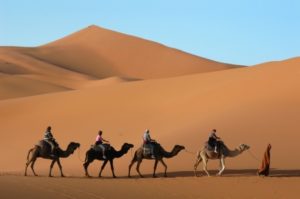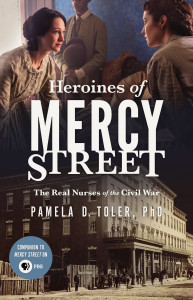By Pamela D. Toler (Regular Contributor)
 In the eighth century CE, after camels were introduced into North Africa, Muslim merchants of North Africa began to organize regular camel caravans across the western Sahara. North African merchants carried luxury goods from across the Islamic world and salt purchased from the desert salt mines to the great trading cities of the Sudan: Timbuktu, Gao, and Djenne. (They also carried Islamic theology and learning, but that’s another story.) They traded for gold and slaves, and to a lesser degree tropical products such as ostrich feathers, ivory and kola nuts. Both sides benefited from the trade. At times a North African merchant could sell his salt for an equivalent weight in gold. According to fourteenth century Muslim historian Ibn Khaldun, by the twelfth century caravans as large as 12,000 camels crossed the desert each year.
In the eighth century CE, after camels were introduced into North Africa, Muslim merchants of North Africa began to organize regular camel caravans across the western Sahara. North African merchants carried luxury goods from across the Islamic world and salt purchased from the desert salt mines to the great trading cities of the Sudan: Timbuktu, Gao, and Djenne. (They also carried Islamic theology and learning, but that’s another story.) They traded for gold and slaves, and to a lesser degree tropical products such as ostrich feathers, ivory and kola nuts. Both sides benefited from the trade. At times a North African merchant could sell his salt for an equivalent weight in gold. According to fourteenth century Muslim historian Ibn Khaldun, by the twelfth century caravans as large as 12,000 camels crossed the desert each year.
It was a dangerous three-month journey along routes that was little more than a string of oases separated by long stretches of featureless desert. But how did it work?
Caravans were temporary associations of merchants who joined together to make the difficult journey under the leadership of a hired caravan leader using camels rented from the nomadic bedouins who lived in the desert. They often included one thousand to five thousand camels and hundreds of people. Typically, a third of the camels carried food and water for the caravan as a whole.
The success of a caravan dependent on the caravan leader, who was typically a desert bedouin. Paid either in cash or as shares of the merchants’ profit, a caravan leader was responsible for navigating the route from watering place to watering place, managing relationships with the desert population–who could quickly turn from service providers to marauders–and supervise the daily work of loading, unloading, and feeding the camels. He had a paid team of laborers, scouts, healers and occasionally a Muslim clergyman to provide services, all generally members of the same bedouin tribe as the leader.
Oases were the critical element. They were resting places where the caravan could find food, water, and fresh camels–the medieval equivalent of the truck stop. Some of the larger oases held regular markets during the caravan season, which typically ran from October to March in order to avoid the worst heat. The failure of a caravan to reach an oasis could mean disaster not only to the caravan but to those who lived at the oasis and depended on the trans-Saharan trade for their survival.
Pamela D. Toler is a freelance writer with a PhD in history and a large bump of curiosity. She is the author of Heroines of Mercy Street: The Real Nurses of the Civil War and is currently working on a global history of women warriors, with the imaginative working title of Women Warriors.

